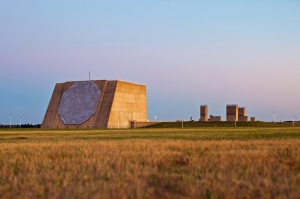Background
The PARCS radar (AN/FPQ-16), located at Cavalier Air Force Station in Northern North Dakota (48.7˚ N, 97.9˚ W), was built as part of the Safeguard ballistic missile defense system, in which it was known as the Perimeter Acquisition Radar Attack Characterization System (PARCS).[1] When Safeguard was shut down in early 1976, after only a few months of operation, the radar continued to operate in missile warning (its new primary mission) and satellite tracking modes. The radar is a collateral sensor in the SSN network.
(photo from:http://www.peterson.af.mil/shared/media/photodb/photos/120112-F-ZZ999-007.jpg)
Technical Characteristics
The single face of the radar is inclined 25º from vertical and it can operate down at least to elevation angle of at least 1.8˚. In azimuth, it is oriented 8˚ east of due north and it has a maximum azimuthal scan of ±70˚ in tracking. Its antenna is octagonal, with a roughly 30 m diameter, and contains 6,144 active antenna elements.
The radar operates at a center frequency of about 442 MHz. Its transmitter uses 128 traveling wave tubes, each of which feeds two 24-element subarrays (48×128 = 6,144 elements). Its average power output is 715 kw, with a peak power of 14.3 MW, corresponding to a duty cycle of 5%. Little information about the pulse lengths used by PARCS appears to be publicly available, but it is known that PARCS can operate at 120 pulses per second.[2] Early PARCS designs considered using a 6 ms pulse length to avoid high peak powers, but shorter pulses and higher peak powers were obtained using the traveling wave tubes.
PARCS performance is tested every 50 ms. If the radar were to produce one pulse every 50 ms, a 5% duty cycle would give a maximum pulse length of 2.5 ms. Linear frequency modulation pulse compression with a compression ratio of 100 is used to obtain its required range resolution (which does not appear to be publicly available).
The transmitter traveling wave tubes currently used are the same as the L-4920 tubes used in ALTAIR dish radar at Kwajalein.[3] As of the mid-1990s, ALTAIR, which also has a maximum 5% duty cycle and for deep space tracking could produce 0.4 ms pulses at a 120 pulses per second or 1.0 ms pulses at 50 pulses per second, with a maximum bandwidth of 4 MHz (using the 0.4 ms pulses) giving a range resolution of 37.5 m.[4] For shorter range tracking ALTAIR is able to produce pulses with bandwidths up to 18 MHz, corresponding to a resolution of about 9.4 m.
The PARCS antenna is subdivided into 24-element receive sub-arrays, each of which feeds one of 256 low-noise amplifiers.
Operations
As of about 1980, in a satellite surveillance mode, PARCS carried out a raster scan covering an area of ±55˚ in azimuth over elevation angles from 1.8˚ to 45˚ in elevation and for ranges of 250 to 3,300 km.[5] The radar normally devotes 45 out of 120 pulses per second to this surveillance pattern, but any of the remaining 75 pulses per second can be used for this surveillance if necessary (its normal missile defense surveillance mode was apparently somewhat different, and the radar could not carry out all of its normal missions while operating in this satellite surveillance mode). Regardless of whether any of these additional pulses are used, the time to scan the entire search volume is less than one minute, and each object is typically detected at least several times while in the search volume.
PARCS Performance Claims
PARCS is less sensitive than the FPS-85.[6] Its sensitivity is “similar” to that of the FPS-85 but its operational range is restricted to about 3,000 km.[7] It can detect a basketball-sized (24 cm) object at a range of 2,000 miles.[8] During tests in the 1970s and 1980s in which some software sensitivity limitations were removed, it detected objects with radar cross sections “well below -30dBsm” (< 9 cm).[9]
[1] Unless otherwise indicated, information in this section is from Chapter 8, “Perimeter Acquisition Radar” in Bell Laboratories, ABM Research and Development at Bell Laboratories: Project History, October 1975. Available at: http://srmsc.org/ref1020.html.
[2] Donald J. Kessler, Preston M. Landry, John R. Gabbard, and John L.T. Moran, “Ground Radar Detection of Meteoroids in Space,” in Ian Halliday and Bruce A. McIntosh, eds., Solid Particles in the Solar System (D. Reidel: Dordrecht, Holland, 1980).
[3] Chris Wheeland, Michael Boyle, Marc Barsanti, and Richard True, “Magnetic Interaction between Traveling Wave Tubes and its Effect on Performance and Reliability,” 2010 IEEE International Vacuum Electronics Conference, IVEC 2010, May 18-20, 2010, pp. 85-86
[4] K.R. Roth, M.E. Austin, D.J. Frediani, G.H. Knittel, and A.V. Mrstik, “The Kiernan Reentry Measurements System on Kwajalein Atoll, The Lincoln Laboratory Journal, Vol. 2, No. 2 (1989). Pp. 247-276; A. Gerber, G. Hogan, M. Corbin, J. Corrado, J. Mathwig, H. Fitzpatrick, S. Murphy, M. Schlueter, J.B. Sherill, and T. White, “Recent Upgrades at the ALTAIR Radar for Improved Space Surveillance Support,” Proceedings of the 1996 Space Surveillance Workshop, April 1996, pp. 81-92.
[5] Kessler et. al., “Ground Radar Detection,” pp. 137-138.
[6] R. Sridharan and Antonio F. Pensa, “U.S. Space Surveillance Network Capabilities,” in C. Bruce Johnson, Timothy D. Maclay and Firooz A. Allahdadi, Image Intensifiers and Applications; and Characteristics and Consequences of Space Debris and Near Earth Objects, Proceedings of SPIE, Vol. 3434, July 1988, pp. 88-100, (p. 93).
[7] Nicholas L. Johnson, “U.S. Space Surveillance,” Advances in Space Research, pp. 8(5)-8(20), (p. (8)9).
[8] “L-3 Communications Awarded $27.7 Million Contract to Supply Traveling Wave Tubes for U.S. Air Force Radar Systems,” Business Wire, December 17, 2003.
[9] Johnson, “U.S. Space Surveillance,” p. (8)9.
